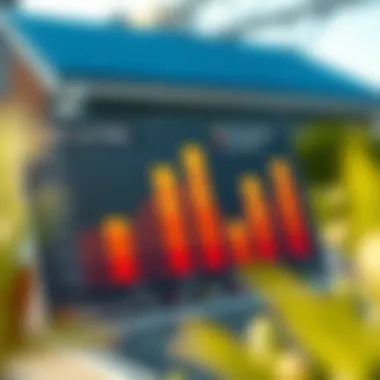Exploring Solar Energy Loan Rates and Options


Intro
In the quest for solar solutions, many factors influence the rates one may encounter. These factors range from personal credit scores to broader market fads. As such, having a grasp on the various loan types, interest rates, and even government incentives can empower individuals to make educated financial decisions.
This article focuses on providing an expansive overview of solar energy loan rates for those looking to invest in sustainability. The information within is tailored for financial enthusiasts ready to explore the dynamics of this growing market. From lenders' offers to market conditions, we will scrutinize every piece of the puzzle. By the end, readers will have the tools at their disposal to not only understand but also effectively manage their investment choices in solar energy.
Prolusion to Solar Energy Loans
Navigating the path toward solar energy solutions often opens a world of financial possibilities, yet understanding solar energy loans is a vital piece of the puzzle. With the rise in environmental awareness and the pursuit of sustainable living, many homeowners are looking into solar installations. However, as exciting as this may sound, the initial investment can be daunting without a clear grasp of financing options available.
Solar energy loans are specially designed to help individuals and businesses afford the costs associated with installing solar systems. By comprehending the nuances of these loans, potential borrowers can make informed decisions that align with their financial goals.
The Importance of Solar Energy
Solar energy represents a shift toward renewable resources, which holds tremendous potential for reducing our carbon footprint. Those who invest in solar energy are not only contributing to a more sustainable future but often find themselves reaping financial rewards in the long run.
- Cost Savings: After the initial investment, solar energy can significantly lower electricity bills. Homeowners may even sell back excess power to the grid, creating potential income streams.
- Energy Independence: By harnessing solar power, individuals gain more control over their energy usage and costs, lessening dependence on traditional energy providers.
- Environmental Impact: Utilizing solar energy is a step toward combating climate change, as it helps decrease greenhouse gas emissions.
Understanding solar energy is essential, but recognizing the financial tools to support these endeavors—such as loans—is equally critical.
Overview of Solar Energy Loans
Solar energy loans vary significantly, catering to different needs, credit ratings, and energy goals. They are designed to make solar adoption accessible to a broader audience. Key types include secured loans, where the solar system itself often acts as collateral, and unsecured loans, which don't require any collateral but may come with higher interest rates.
Borrowers might also explore home equity loans, which leverage accumulated home value, or finance options offered directly through solar providers. Each type carries its own interest rates and terms, influenced by multiple factors. To put it simply, knowing what type of loan suits your situation can make the difference between a seamless investment and a financial headache.
In summary, understanding the landscape of solar energy loans is critical for anyone looking to invest in solar solutions. With this knowledge, borrowers can better navigate financing options, optimize their investments, and contribute to a sustainable future.
Types of Solar Energy Loans
When venturing into the world of solar energy financing, the types of loans available can shape your investment journey significantly. Understanding these options is crucial for anyone looking to leverage renewable energy while keeping their finances in check. Each loan type has its distinct characteristics, advantages, and challenges, making it essential to choose the one that suits your needs best.
Secured Loans
Secured loans are backed by collateral, typically the property itself. This arrangement often leads to lower interest rates compared to unsecured loans, primarily because lenders face lower risks. By pledging an asset, individuals can access larger loan amounts, which is critical for funding substantial solar installations. If you're a homeowner leaning towards solar energy, a secured loan might provide the financial leverage you need. However, it's important to remember that failing to keep up with payments may put your property at risk.
Unsecured Loans
Unsecured loans do not require collateral, which means borrowers won’t risk their assets if they encounter financial difficulties. They tend to be easier to qualify for, making them appealing for those who may not have significant equity in their home or sufficient assets to secure a loan. However, with no collateral backing, lenders might charge higher interest rates. It’s a pragmatic option if you’re looking to dip your toes into solar energy without committing your property.
Home Equity Loans
Home equity loans are another avenue, allowing homeowners to tap into the value of their home. Whether your roof is full of solar panels already or you're just considering an upgrade, these loans can be a smart choice. Because they are secured against your home’s equity, you may enjoy relatively low rates. However, they do come with the weight of long-term commitment and risk, given that failure to repay could jeopardize your home.
Financing Through Solar Companies
Many solar providers offer financing solutions directly. This approach can simplify the purchasing process, as it often combines the upfront costs with manageable payment plans tailored to your financial circumstances. Some companies might even provide zero-interest financing for a period, making solar more accessible. However, it is vital to scrutinize the terms and conditions, as rates might not be as favorable in the long run compared to traditional financing.
In summary, determining the right type of solar energy loan involves weighing the pros and cons of each option against your financial situation and your long-term goals. Each type of loan has its intricacies, but knowing what to expect can significantly streamline your journey into solar energy.
Factors Influencing Solar Energy Loan Rates
When considering solar energy loans, it’s crucial to grasp how various factors influence the rates offered by lenders. Understanding these elements can save borrowers a significant sum of money and time. This section sheds light on several key determinants that dictate loan rates, equipping potential borrowers with valuable insights.
Credit Score Impact
One of the predominant factors influencing solar energy loan rates is the borrower’s credit score. Lenders use this score as a key indicator of the borrower’s creditworthiness. If you have a high credit score, you are more likely to qualify for lower interest rates. Think of it as a grading system; the higher the grade you’ve earned, the better the terms you can negotiate. Conversely, a lower score can mean higher rates or even challenges in getting approved for a loan.
In practical terms, a score of 740 or above generally lands borrowers the most favorable rates. According to lending experts, improving your credit score before applying for a loan can make a significant difference. This might include paying down existing debts or settling outstanding bills. For more information on how to check and improve your credit score, visit NerdWallet.
Loan Amount and Term Length
The loan amount and term length also play a pivotal role. Larger loans often come with slightly higher rates due to the increased risk for the lender. This is especially true if the loan amount exceeds typical thresholds, which might flag additional scrutiny during the application process. However, a longer loan term typically leads to lower monthly payments, but it can also mean that you end up paying more in interest over time.
For instance, a $20,000 loan with a 15-year term might have a different rate than the same loan over a 25-year term. Borrowers need to weigh their options carefully. Shorter terms usually have lower rates, but they demand higher monthly payments. Deciding on the balance between affordable payments and total interest paid requires some strategic thinking.
Market Interest Rates


Market interest rates fluctuate based on economic conditions and the prevailing economic climate. These rates play a significant role because they directly affect the rates lenders can offer to consumers. When the Federal Reserve adjusts its rates, it often has a ripple effect through the lending market. Higher market rates usually lead to increased loan rates, while a dip in these rates may have the opposite effect.
For those looking into solar loans, staying informed about market conditions can offer a significant advantage. By timing your loan application during lower market rates, you might secure a better deal. Keep an eye on resources like Investopedia or Bloomberg for insights on current market trends.
Geographic Considerations
Geographic factors can’t be overlooked when assessing loan rates for solar investments. Different states and regions may have varying lending regulations, incentive programs, and solar energy market conditions. For example, states that have strong solar incentives, like California, may offer better financing terms than states with less solar adoption.
The impact of local energy policies, availability of solar resources, and competition among lenders also shapes loan options. Therefore, potential borrowers should research local lenders and incentives tailored to their geographic area. Websites like DSIRE can be quite helpful in uncovering state-specific incentives.
"Understanding the local lending environment and the regional demand for solar energy could mean the difference between a good rate and a great one."
In summary, several intertwined factors influence solar energy loan rates, from personal financial standing to broader economic indicators and geographical specifics. Learning about these elements allows potential borrowers to make informed decisions, thereby maximizing their investment in solar energy.
Government Incentives and Their Effect on Loan Rates
When it comes to the world of solar energy financing, government incentives play a pivotal role in shaping the loan landscape. These incentives not only encourage homeowners and businesses to invest in renewable energy solutions but also directly affect the financial terms and conditions of loans available for solar projects. By understanding these incentives, potential borrowers can make more informed decisions about financing their solar investments, maximizing savings and reducing overall costs.
Federal Tax Credits
One significant incentive offered by the federal government is the solar federal tax credit, known as the Investment Tax Credit (ITC). Currently, this credit allows borrowers to deduct a substantial percentage of the cost of installing a solar energy system from their federal taxes. For example, if you spend $20,000 on a solar installation, you can deduct 26% of that amount, which translates to a $5,200 reduction in your tax liability. This type of incentive not only lowers the upfront cost but also enhances the attractiveness of solar loans. Lenders may offer more favorable rates knowing that borrowers have the potential to recoup a portion of their expenses through tax credits.
"A good tax system should be like a good solar system; it rewards those who invest in energy independence and sustainability."
State-Specific Incentives
On top of federal tax credits, numerous states have their own incentive programs. These might include tax credits, rebates, or low-interest loans designed specifically for solar energy projects. For instance, California has various rebate programs for residential solar systems, which serve to offset installation costs significantly. Likewise, states like New York have established programs that offer favorable financing options with reduced interest rates for solar installations.
The impact of these incentives is tangible. They can lower borrowing costs, making solar loans more accessible for many families and businesses. Thus, when exploring loan options, understanding what state-specific incentives are available is crucial, as they can be a game changer in the affordability of solar investments.
Grants and Rebates
In addition to tax credits and state-specific incentives, grants and rebates can further reduce the financial burden of solar investments. These are funds provided by government entities or non-profit organizations which do not need to be repaid, unlike loans. For example, various non-profit organizations may provide grants to homeowners who meet certain income criteria or live in designated areas.
Additionally, many utility companies offer rebates for customers who adopt solar power as part of their energy mix. Such initiatives not only help to offset initial costs but can also improve the terms on which solar loans are offered. When lenders see that borrowers can leverage grants or rebates, they might provide more competitive rates, knowing that the risk profile of the borrower is significantly improved.
In summary, understanding how government incentives, tax credits, grants, and rebates influence solar energy loan rates is paramount for anyone looking to finance solar projects. These elements can lead to lower loan amounts, reduced interest rates, and potentially higher returns on investment in solar solutions. By piecing together this information, borrowers can uncover options that align with their financial goals while contributing to a sustainable future.
Finding the Right Lender for Solar Loans
Selecting the right lender for solar loans is a pivotal step in the journey toward harnessing solar power for your home or business. This crucial decision can significantly influence your financial experience, from interest rates to repayment terms. With a myriad of options available, understanding the landscape can empower potential borrowers to make informed choices.
Comparing Lender Options
When it comes to solar loans, it's not just about finding a lender; it's about finding the right lender that suits your financial needs. Comparing lender options can help uncover differences in offerings, interest rates, and customer service. Here are some aspects to consider:
- Interest Rates: Different lenders may offer varying rates, dependent on your creditworthiness and loan type. Look for competitive rates that align with your budget.
- Customer Service: The quality of customer service can affect your borrowing experience. Research lender reviews online to assess their reliability and customer satisfaction levels.
- Loan Flexibility: Check if lenders offer options for adjusting payment plans or early repayment without hefty penalties.
- Pre-Approval Process: Some lenders may provide a pre-approval process, allowing you to gauge your eligibility before formally applying.
This side-by-side analysis can shine a light on which financial institution or company might fit best with your solar energy objectives.
Traditional Banks vs. Credit Unions
When comparing traditional banks to credit unions for solar loans, there are notable differences worth considering.
Traditional banks typically have a more extensive reach and offer a wider variety of loan products. However, their interest rates can often be higher due to the overhead costs associated with larger operations. Additionally, they might enforce stricter lending criteria, requiring a solid credit history and significant down payment.
Credit unions, on the other hand, can be more flexible. Because these are non-profit organizations, they often provide lower interest rates and more favorable terms for their members. Joining a credit union may, however, necessitate membership based on specific criteria, such as geographic location or employment.
In many cases, credit unions blend personal attention with competitive rates. Borrowers seeking personalized guidance might find credit unions a more appealing option.
Online Lenders
The rise of technology has ushered in a new class of lenders: online lenders. These institutions provide accessible and often streamlined application processes. Here are the standout elements of working with online lenders:
- Speed: Online lenders frequently offer quicker approval and funding times compared to traditional banks or credit unions. This advantage can be particularly appealing for individuals looking to move swiftly towards their solar investment.
- Simplified Application Process: The process tends to be straightforward and user-friendly, often displayed on a neat digital platform. You can easily upload documents and communicate with their teams directly.
- Variety of Options: Many online lenders specialize in solar loans and may offer tailored products, potentially simplifying comparisons across loan types.
However, as with any option, exercise due diligence. Evaluate the reputation of the online lender, scrutinizing user feedback and service history to avoid potential pitfalls.


Overall, when exploring lender options for solar loans, understanding the nuances between traditional banks, credit unions, and online lenders can reveal the most fitting partnership for financial success. It’s about aligning your solar dreams with the lending path that best supports them.
Evaluating Solar Energy Loan Terms
When delving into solar energy loans, the terms under which these loans operate are crucial. Choosing the right loan can save a borrower significant amounts of money over time. Evaluating the terms allows potential borrowers to understand not just the initial costs, but also the long-term implications of their financing choices. Here, the spotlight is on several factors that can impact affordability and value when taking out a solar loan. Unpacking these terms is essential for making informed decisions and ensuring financial well-being.
Interest Rates Compared
Interest rates represent one of the most critical components of solar loans. Changes in the rate can lead to significant differences in the overall cost of financing. Borrowers will find that rates can vary widely based on factors such as credit score, loan type, and market conditions. For instance, someone with excellent credit may be offered rates as low as 3% or 4%, whereas individuals with poorer credit scores could see rates soaring to 8% or more. A difference of just a few percentage points can lead to thousands of dollars in extra interest over the lifespan of the loan. It’s therefore essential to shop around and compare different offers from various lenders.
This investigation into interest rates should be thorough. Make sure to scrutinize terms such as the Annual Percentage Rate (APR), which includes not just the base interest rate but also fees, and other costs. Therefore, an APR of 5% can be misleading if It is associated with a plethora of fees. Also be mindful that fixed rate loans hold steady over time, while variable rates can fluctuate, possibly leading to higher payments down the line when interest rates in the market shift. Ultimately, understanding how these rates stack up against each other will empower borrowers to make better choices and secure favorable financial outcomes.
Fees and Associated Costs
Often overlooked, fees and associated costs can heavily impact the overall borrowing experience. When considering a solar energy loan, borrowers should inquire about several forms of fees: application fees, origination fees, and even processing fees. For instance, a lender may charge a one-time origination fee of around 1% of the loan amount, adding significantly to the total costs.
Examine these fees closely—often, they can add up to hundreds of dollars, and in some cases, thousands. It’s important to differentiate between upfront costs and those that might emerge later. Additionally, appraisal or inspection costs can crop up, especially in secured loans, where collateral is needed to back the loan.
An effective way to remain vigilant is by breaking down the total loan amount into manageable pieces. Borrowers can ask lenders for a detailed loan estimate. This document should include an itemized list of all upfront costs and fees, allowing a clearer view of what one will ultimately pay versus the amount borrowed. Hidden charges can turn an excellent interest rate into a poor deal if the fees are excessive, so clarity is key.
Prepayment Penalties
Prepayment penalties can be a thorn in the side for borrowers wanting to save money early in the loan’s lifetime. These penalties are fees incurred when a borrower pays off their loan earlier than anticipated, depriving the lender of future interest revenue. Some lenders impose strict penalties that can amount to thousands of dollars, which can deter one from refinancing or selling their home if the loan proves to be less favorable in later years.
It is wise for borrowers to closely read the fine print regarding prepayment terms. Not all lenders enforce penalties; indeed, some may allow borrowers to pay off their loans early without incurring additional costs. Knowing this ahead of time can provide flexibility, particularly if market conditions change or if the borrower’s financial situation improves substantially after the loan is taken. Negotiating this term can greatly enhance overall satisfaction with the loan, as well as prevalence of future financial choice.
"Understanding the terms associated with solar energy loans can prevent future regrets and help secure a brighter financial path."
In summary, evaluating solar energy loan terms is not just a formality; it influences how manageable and beneficial the investment will be over time. By focusing on interest rates, hidden fees, and penalties for prepayment, borrowers can make astute choices that align with their financial goals.
For further reading on the dynamics of interest rates, check out Wikipedia on Interest Rates.
For practical tips on loan comparison, visit NerdWallet for Loan Comparisons.
The Application Process for Solar Loans
When someone decides to invest in solar energy, the application process for securing a loan is a crucial step. It’s not just about getting funding; it shapes the entire experience of investing in a solar system. Understanding what’s involved can empower future borrowers to be better prepared and informed.
Documentation Requirements
The first hurdle in obtaining a solar loan is gathering the necessary documentation. This process can often feel laborious, but it is essential for smooth sailing through the application phase. Every lender may have their own list of requirements, but generally, you can expect the following:
- Personal Identification: A valid ID like a driver’s license or passport.
- Proof of Income: Recent paycheck stubs, tax returns, or bank statements to show your earnings.
- Credit History: A report from credit agencies so lenders can assess risk.
- Homeownership Proof: Documents like the title deed, mortgage statement, or property tax records to confirm ownership and your connection to the residential property.
- Project Estimates: Detailed quotes from authorized solar installation contractors that outline proposed work.
Taken together, these documents provide a comprehensive picture of your financial health and your commitment to adopting solar energy solutions. If you’re organized and proactive about assembling this paperwork, it could make the entire process run smoother.
Understanding Loan Approval Timelines
Once you've submitted your application, patience becomes your best friend. The time it takes to get loan approval can vary widely. It's influenced by several factors, including the lender's workload and how complete your application is. Here’s a rough framework for what you can expect:
- Initial Review: When you submit your application, the lender will perform an initial review within a few days.
- Decision Making: After the initial review, expect another week or two for a deeper analysis to ensure you meet all requirements.
- Final Approval: If everything checks out, lenders generally finalize your loan within a week post-decision.
In total, the process might take anywhere from a few weeks up to a month. If additional information is needed or complications arise, it could stretch even longer. Being aware of these timelines can help you set realistic expectations and plan accordingly.
"Patience is not simply the ability to wait – it’s how we behave while we’re waiting."
Benefits of Financing Solar Investments
Financing solar investments is more than just a mechanism to pay for shiny new panels; it’s about making a smart choice for your future and your wallet. A pivotal aspect of solar energy loans is recognizing how this type of financing can lead to tangible benefits for the borrower and the broader community.
Three primary advantages stand out when you delve into the benefits of financing solar investments: long-term savings, increased property value, and environmental impact. These elements work hand in hand, making solar financing a compelling option for those looking to reduce their utility bills while also contributing to a sustainable future.
Long-Term Savings
When you opt for solar financing, one of the most prominent benefits is the potential for substantial long-term savings. Initially, the cost of purchasing solar panels and installation can be daunting. However, many people overlook how these costs are often offset over time through reduced energy bills.
- Lowers utility bills: After the panels are installed, homeowners typically see a significant decrease in their monthly energy expenses, providing tangible savings month-over-month.
- Predictable expenses: With solar financing, payments can be more predictable than fluctuating utility prices, leading to better budgeting for the household.
- Financing options: The variety of financing options available can also make solar more accessible. Affordably structured loans mean that even upfront expenses can be broken down into manageable payments.


The power of sunlight can cut down energy costs, paving the way for individuals to save upward of thousands over the lifespan of their solar system.
"Investing in solar energy is like planting a money tree in your backyard. As it grows, it will bear fruit in the form of savings."
Increased Property Value
Another benefit worth highlighting is the boost in property value that solar investments can deliver. In today’s real estate market, homes with solar panels are often seen as more attractive. Here’s why:
- Desirability: More buyers are keen on energy-efficient homes. Solar-equipped properties can stand out as a proactive choice in a competitive market, yielding better offers than similar homes without solar.
- Market appeal: Research shows that homes with solar panels can sell for a premium—often around 4% more—than those without. This increased market value can be a persuasive draw for prospective buyers.
- Long-term investment: Ultimately, homes with solar capabilities not only appeal to buyers but indicate a commitment to sustainability, which can resonate strongly with the modern consumer.
The benefits of solar financing extend far beyond immediate savings. It enhances the overall value of the property, ensuring that homeowners not only invest in renewable energy but also set themselves up for a profitable return down the line.
In summary, solar financing opens up a world of possibilities, making it a viable option for homeowners to solve the challenges of rising energy costs while playing an essential role in environmental conservation. By understanding these benefits, financing becomes an entry point into a more sustainable lifestyle.
Challenges and Considerations in Solar Lending
When it comes to financing solar energy options, the road can get a bit bumpy. This section looks into the challenges that may crop up as potential borrowers navigate through the world of solar lending, alongside vital considerations that should be kept in mind.
Economic Factors
In the realm of solar loans, the economic landscape plays a crucial role in shaping interest rates and lending options. The health of the economy can affect everything from the availability of credit to the appetite of lenders. When the economy is booming, banks might be more willing to offer attractive loan terms due to increased competition among lenders. Conversely, in times of economic downturn, such as during a recession, lenders may tighten their belts, leading to higher interest rates or stricter loan eligibility criteria.
- Inflation: This sneaky villain can raise costs across the board. Borrowers may find that, as inflation takes its toll, what seemed like a good deal on a solar loan today may not hold the same value tomorrow. An increased cost of living could make monthly payments more burdensome.
- Market Dynamics: Economic cycles—like the ebb and flow of tides—can influence the flow of funds towards renewable sources like solar energy. When investors feel bullish about the solar sector, it can lead to lower rates. On the flip side, concern about market stability can cause lenders to hesitate, pushing rates up and making financing less favorable.
Being aware of these economic factors isn’t just a nice-to-know; it’s essential for a borrower to time their acquisition wisely and secure the best rates available.
Environmental Considerations
The solar energy landscape isn’t just about finances; environmental aspects also hold sway over lending options. Lenders increasingly recognize the importance of aligning their financing activities with sustainable practices. Here are a few elements that are making waves in the environmental sector:
- Sustainability Initiatives: Many loan programs favor projects that promise not just profit but also community and environmental benefits. Thus, borrowers who can demonstrate an alignment with sustainability goals may unlock better rates or additional incentives.
- Climate Change Impact: Lenders are increasingly factoring climate risk into their assessments, leading to a shift in how solar projects are viewed. For instance, if a project is located in an area susceptible to extreme weather events, lenders may impose higher rates due to perceived risk. It's a tale of risk and reward, where those who can prove resilience may end up with favorable terms.
- Regulatory Considerations: Different regions have different regulations affecting solar loans. Some areas are more conducive to solar investment due to favorable laws, financial incentives, or a supportive local government. Potential borrowers should conduct due diligence to ensure that they’re well-informed about local regulations and environmental trends that might impact their financing options.
"Understanding both economic and environmental factors is key to gaining an edge when seeking solar loans. Knowledge is power in the lending game."
In sum, while the prospects for solar energy financing are promising, they come with their fair share of challenges. By being aware of economic fluctuations and environmental implications, potential borrowers can better position themselves in the solar marketplace. It’s not just about lights and panels; it’s about understanding the whole context in which these loans operate.
The Future of Solar Energy Financing
The landscape of solar energy financing is evolving rapidly, influenced by a myriad of factors. As solar technology becomes more accessible, so do the financing options. Understanding the future of solar energy financing is critical for financial enthusiasts and individual investors alike. It informs how they can best invest in renewable energy and navigate the shifting dispensations of loan rates. Several specific elements play a pivotal role in shaping this future, ranging from trends in loan rates to emerging technologies.
Trends in Loan Rates
In recent years, loan rates for solar energy systems are, quite frankly, a mixed bag. There have been fluctuations based on macroeconomic changes, including Federal Reserve adjustments to interest rates. But there's more to the story. As the demand for solar panels grows, lenders are adapting—some offering competitive rates that may be lower than traditional loans.
- Market Trends: The solar industry is budding with innovation, and lenders are taking notice. Products like Power Purchase Agreements (PPAs) and lease arrangements are reshaping how financing is structured. With the allure of minimal upfront costs, these options are drawing more borrowers into the fold.
- Government Influence: Tax incentives and rebates act like a double-edged sword. While they can enhance energy savings, they also push lenders to tweak their rates to remain competitive. As public policies shift, the loan rates often reflect this dynamism.
- Seasonal Fluctuations: Some lenders might offer limited-time promotions during peak solar installation seasons, creating an environment where savvy investors can snag better deals.
As such, keeping an eye on overall economic trends and potential government interventions will provide valuable insight into future loan rates.
Emerging Technologies and Innovations
Emerging technologies are not just buzzword bingo; they are fundamentally altering the solar energy space, influencing everything from efficiency to financing structures and consequently the loan rates.
One key area is the advent of battery storage solutions. These systems enable excess solar power generated during peak sunlight hours to be stored for later use, enhancing energy independence. As these technologies become commonplace, loan products tailored specifically for them are likely to emerge, opening new avenues for financing.
- Smart Technology Integration: With the integration of smart technology and IoT devices in solar systems, there’s potential for lenders to offer customized solutions catering to unique energy needs. For instance, those adopting smart grid technology may enjoy specific financing options that are better aligned with their usage patterns.
- Sustainability Tracking: Lenders may begin incorporating sustainability metrics into their financing models, providing better rates for installations that meet certain environmental standards. This could pave the way for a green finance revolution.
- Crowdfunding Platforms: Innovative financing platforms are also shaking things up. Crowdfunding for solar projects is gaining traction, allowing everyday folks to invest in community energy initiatives while enabling funders to tap into finance for their solar needs without high-interest loans.
Overall, as we move forward, the importance of staying informed about these technological advancements cannot be overstated. With both loan rates and financing options at stake, the future looks promising yet uncertain for solar energy investments.
"The only constant in the world of solar energy financing is change."
Staying ahead of these trends will be essential for astute investors who wish to make financially sound decisions in the renewable energy sector.
Ending
When diving into the realm of solar energy financing, the conclusion plays a pivotal role. It encapsulates the journey the reader has embarked upon throughout this article, tying together the intricate web of loan rates, types, and influencing factors.
Summarizing Key Points
In this article, we have covered several essential areas:
- Types of Solar Loans: We explored various loans available, including secured, unsecured, and financing options through solar companies. Each type has its own set of perks and pitfalls to consider.
- Factors Influencing Loan Rates: Understanding how credit scores, loan amount, term lengths, market conditions, and geographic factors can affect loan rates is crucial to making smart financial choices.
- Government Incentives: The article highlighted the invaluable federal and state incentives, including tax credits, that can significantly reduce the financial burden of solar investments.
- Lender Options: We discussed the differences between traditional banks, credit unions, and online lenders, offering insight into how to find the best fit for your needs.
- Evaluating Loan Terms: By comparing interest rates, fees, and potential penalties, readers were given the tools to critically assess loan offers.
- Future Trends: Finally, we touched on emerging trends in solar financing and how they may affect loan rates in the years to come.
This holistic view of solar energy loan rates serves as a foundation for making better borrowing decisions. With a solid understanding of these aspects, individual investors and financial enthusiasts alike can take steps toward realizing their goals related to solar energy investment.



